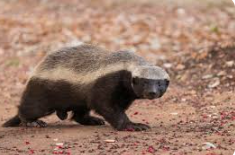TAG: GS-3: ECOLOGY AND ENVIRONMENT
CONTEXT: The recent discovery of a honey badger in the Terai forests of Uttarakhand has generated much buzz and renewed calls for conservation efforts in the region.
EXPLANATION:
About honey badger:
- The honey badger, one of the toughest mammals in Africa and western Asia.
- Honey badgers are tiny, hardy mammals. It’s a weasel, like a skunk. Honey badgers are Mellivora capensis. Honey badgers live in African and Asian forested environments. Their muscular front legs dig their holes.
- Honey badgers are related to skunks, otters, ferrets, and other badgers. Honey is the ratel’s preferred meal, thus the nickname honey badger. They devour honeybee larvae.
- This animal has a stocky, flattened body, short, powerful legs, and large front claws for digging and defence. Honey badgers have thick, dense, black fur with a broad grey-white stripe from head to tail.
- Night-active honey badgers. Scorpions, termites, and worms are their food. Porcupines, rabbits, turtles, and snakes are their prey. Honey badgers pursue a little bird for honey and bee larvae. Honeyguides consume beeswax and larvae. Honey badger glands stink. Honey badgers utilise their scent to repel bigger animals.
- The honey badger is protected under Schedule I of the Wildlife (Protection) Act of 1972, ensuring the highest level of legal protection in India.
- Global Status: Although listed as “Least Concern” on the IUCN Red List, it is rarely seen in India, highlighting the need for specific conservation efforts.
What is Terai Forest?
The Terai or Tarai is a lowland region in parts of southern Nepal and northern India that lies to the south of the outer foothills of the Himalayas, the Sivalik Hills and north of the Indo-Gangetic Plain. This lowland belt is characterised by tall grasslands, scrub savannah, sal forests and clay rich swamps.


About the Terai-Arc Landscape:
- It is an 810km stretch between the river Yamuna in the west and the river Bhagmati in the east.
- It comprises the Shivalik hills, the adjoining bhabhar areas and the Terai flood plains.
- It is spread across the Indian states of Uttarakhand, Uttar Pradesh and Bihar, and the low-lying hills of Nepal.
- About 22% of the wild tiger population in India is found across the TAL, living amidst some of the highest human and livestock densities on the subcontinent.
- The landscape boasts of some of India’s most well-known Tiger Reserves and Protected Areas such as Corbett Tiger Reserve, Rajaji National Park, Dudhwa Tiger Reserve, Valmiki Tiger Reserve and Nepal’s Bardia Wildlife Sanctuary, Chitwan National Park, and Sukhla Phanta Wildlife Sanctuary
- These forests are home to three flagship species, the Bengal tiger (Panthera tigris), the greater one horned rhino (Rhinoceros unicornis) and the Asian elephant (Elephas maximus).
Source:
Spread the Word
